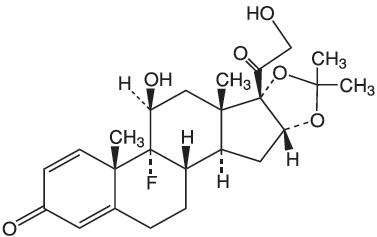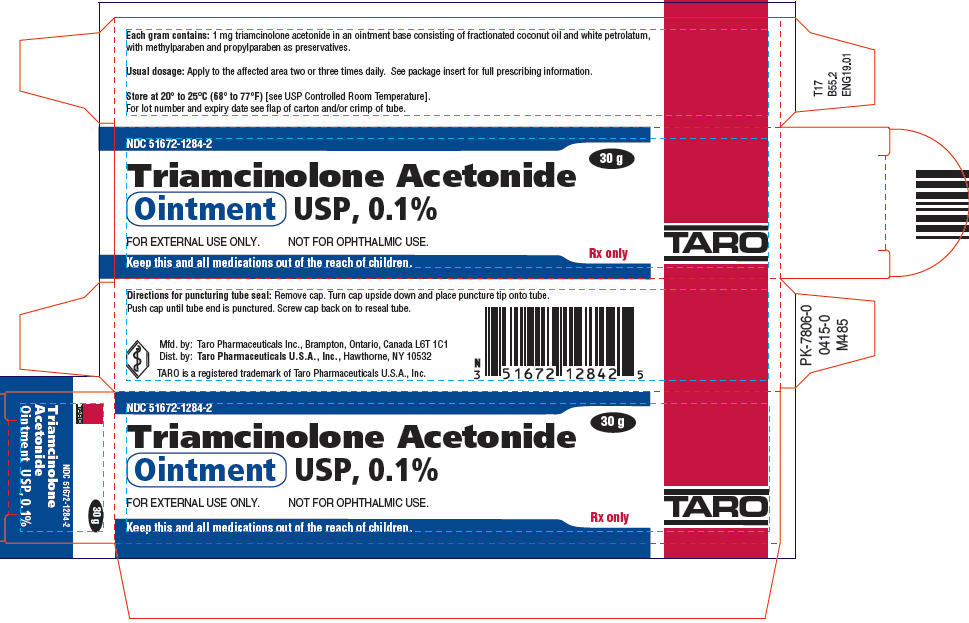What Is Triamcinolone Acetonide Cream 0.1 Used To Treat?
For Dermatologic Employ Just
Not For Ophthalmic Employ
Rx Only
Description
The topical corticosteroids establish a class of primarily constructed steroids used as anti-inflammatory and anti-pruritic agents. The steroids in this class include triamcinolone acetonide. Triamcinolone acetonide is designated chemically equally pregna-1,4-diene-3,20-dione, 9-fluoro-11,21-dihydroxy-xvi,17-[(1-methylethylidene)bis(oxy)]-, (11β,16α)-. The structural formula is:
 | |
| Molecular Weight: 434.51 | Molecular Formula: C24H31FO6 |
Each gram of Triamcinolone Acetonide Ointment USP, 0.1% contains i mg triamcinolone acetonide, in an ointment base of fractionated coconut oil and white petrolatum, with methylparaben and propylparaben as preservatives.
CLINICAL PHARMACOLOGY
Topical corticosteroids share anti-inflammatory, anti-pruritic and vasoconstrictive actions. The mechanism of anti-inflammatory activity of the topical corticosteroids is unclear. Various laboratory methods, including vasoconstrictor assays, are used to compare and predict potencies and/or clinical efficacies of the topical corticosteroids. At that place is some evidence to suggest that a recognizable correlation exists between vasoconstrictor potency and therapeutic efficacy in homo.
Pharmacokinetics
The extent of percutaneous absorption of topical corticosteroids is adamant by many factors including the vehicle, the integrity of the epidermal bulwark, and the utilize of occlusive dressings. Topical corticosteroids tin can be absorbed from normal intact peel. Inflammation and/or other disease processes in the skin increment percutaneous assimilation. Occlusive dressings substantially increase the percutaneous absorption of topical corticosteroids. Thus, occlusive dressings may be a valuable therapeutic adjunct for treatment of resistant dermatoses (run across DOSAGE AND Assistants). Once captivated through the peel, topical corticosteroids are handled through pharmacokinetic pathways similar to systemically administered corticosteroids. Corticosteroids are jump to plasma proteins in varying degrees. Corticosteroids are metabolized primarily in the liver and are so excreted by the kidneys. Some of the topical corticosteroids and their metabolites are too excreted into the bile.
INDICATIONS AND USAGE
Triamcinolone Acetonide Ointment is indicated for the relief of the inflammatory and pruritic manifestations of corticosteroid-responsive dermatoses.
CONTRAINDICATIONS
Topical corticosteroids are contraindicated in those patients with a history of hypersensitivity to any of the components of the preparation.
PRECAUTIONS
General
Systemic absorption of topical corticosteroids has produced reversible hypothalamic-pituitary-adrenal (HPA) centrality suppression, manifestations of Cushing's syndrome, hyperglycemia, and glucosuria in some patients.
Conditions which broaden systemic absorption include the application of the more potent steroids, use over large surface areas, prolonged use, and the addition of occlusive dressings.
Therefore, patients receiving a large dose of any potent topical steroid applied to a large surface surface area or under an occlusive dressing should be evaluated periodically for prove of HPA axis suppression by using the urinary complimentary cortisol and ACTH stimulation tests, and for impairment of thermal homeostasis. If HPA centrality suppression or elevation of the body temperature occurs, an attempt should exist made to withdraw the drug, to reduce the frequency of awarding, substitute a less potent steroid, or apply a sequential arroyo when utilizing the occlusive technique.
Recovery of HPA axis function and thermal homeostasis are by and large prompt and complete upon discontinuation of the drug. Infrequently, signs and symptoms of steroid withdrawal may occur, requiring supplemental systemic corticosteroids. Occasionally, a patient may develop a sensitivity reaction to a detail occlusive dressing cloth or adhesive and a substitute material may be necessary.
Children may blot proportionally larger amounts of topical corticosteroids and thus be more susceptible to systemic toxicity (see PRECAUTIONS-Pediatric Utilize).
If irritation develops, topical corticosteroids should exist discontinued and advisable therapy instituted. In the presence of dermatological infections, the use of an appropriate antifungal or antibacterial agent should be instituted. If a favorable response does not occur promptly, the corticosteroid should be discontinued until the infection has been adequately controlled.
These preparations are not for ophthalmic employ.
Information for Patients
Patients using topical corticosteroids should receive the following data and instructions:
- This medication is to be used as directed by the physician. It is for external apply only. Avoid contact with the eyes.
- Patients should be advised non to use this medication for whatsoever disorder other than for which it was prescribed.
- The treated skin area should non exist bandaged or otherwise covered or wrapped as to be occlusive unless directed by the physician.
- Patients should report any signs of local adverse reactions specially under occlusive dressing.
- Parents of pediatric patients should be advised not to use tight-fitting diapers or plastic pants on a kid beingness treated in the diaper surface area, as these garments may constitute occlusive dressings.
Laboratory Tests
A urinary free cortisol examination and ACTH stimulation test may be helpful in evaluating HPA axis suppression.
Carcinogenesis, Mutagenesis, Impairment of Fertility
Long-term animate being studies have not been performed to evaluate the carcinogenic potential or the effect on fertility of topical corticosteroids. Studies to determine mutagenicity with prednisolone and hydrocortisone showed negative results.
Pregnancy
Teratogenic Effects
Pregnancy Category C
Corticosteroids are more often than not teratogenic in laboratory animals when administered systemically at relatively depression dosage levels. The more potent corticosteroids have been shown to be teratogenic after dermal application in laboratory animals. In that location are no adequate and well-controlled studies in pregnant women on the teratogenic effects from topically practical corticosteroids. Therefore, topical corticosteroids should be used during pregnancy only if the potential do good justifies the potential adventure to the fetus. Drugs of this class should not exist used extensively on pregnant patients, in large amounts, or for prolonged periods of time.
Nursing Mothers
It is not known whether topical administration of corticosteroids could issue in sufficient systemic absorption to produce detectable quantities in breast milk. Systemically administered corticosteroids are secreted into chest milk in quantities not likely to have a deleterious effect on the infant. All the same, circumspection should be exercised when topical corticosteroids are administered to a nursing woman.
Pediatric Apply
Pediatric patients may demonstrate greater susceptibility to topical corticosteroid-induced HPA axis suppression and Cushing's syndrome than mature patients because of a larger peel surface expanse to torso weight ratio.
Hypothalamic-pituitary-adrenal (HPA) axis suppression, Cushing's syndrome and intracranial hypertension have been reported in children receiving topical corticosteroids. Manifestations of adrenal suppression in children include linear growth retardation, delayed weight proceeds, depression plasma cortisol levels, and absenteeism of response to ACTH stimulation. Manifestations of intracranial hypertension include bulging fontanelles, headaches, and bilateral papilledema.
Administration of topical corticosteroids to children should be limited to the least amount compatible with an effective therapeutic regimen. Chronic corticosteroid therapy may interfere with the growth and development of children.
Agin REACTIONS
The following local agin reactions are reported infrequently with topical corticosteroids, simply may occur more than frequently with the use of occlusive dressings. These reactions are listed in an approximate decreasing order of occurrence: called-for, itching, irritation, dryness, folliculitis, hypertrichosis, acneiform eruptions, hypopigmentation, perioral dermatitis, allergic contact dermatitis, maceration of the skin, secondary infection, skin cloudburst, striae, and miliaria.
OVERDOSAGE
Topically applied corticosteroids can be absorbed in sufficient amounts to produce systemic effects (see PRECAUTIONS, Full general).
DOSAGE AND Administration
Utilize a thin motion-picture show of the 0.i% Triamcinolone Acetonide Ointment, as appropriate, to the affected expanse 2 to iii times daily.
Occlusive Dressing Technique
Occlusive dressings may exist used for the management of psoriasis or other recalcitrant conditions. Use a sparse motion-picture show of ointment to the lesion, cover with a pliable nonporous film, and seal the edges. If needed, additional moisture may exist provided past covering the lesion with a dampened clean cotton wool material before the nonporous film is applied or by briefly wetting the affected area with water immediately prior to applying the medication.
The frequency of irresolute dressings is best determined on an individual basis. It may exist convenient to employ Triamcinolone Acetonide Ointment under an occlusive dressing in the evening and to remove the dressing in the morning (i.eastward., 12-hour occlusion).
When utilizing the 12-60 minutes occlusion regimen, boosted ointment should be applied, without occlusion, during the day. Reapplication is essential at each dressing change.
If an infection develops, the employ of occlusive dressings should be discontinued and appropriate antimicrobial therapy instituted.
HOW SUPPLIED
Triamcinolone Acetonide Ointment USP, 0.1% is supplied in 15 one thousand (NDC 51672-1284-1), xxx g (NDC 51672-1284-2), and 80 thou (NDC 51672-1284-viii) tubes.
Store at twenty° to 25°C (68° to 77°F) [see USP Controlled Room Temperature].
Mfd. by: Taro Pharmaceuticals Inc., Brampton, Ontario, Canada L6T 1C1
Dist. past: Taro Pharmaceuticals UsA., Inc., Hawthorne, NY 10532
Revised: December, 2016
PK-1203-v
76
Primary DISPLAY PANEL - xxx chiliad Tube Carton
NDC 51672-1284-2
30 g
Triamcinolone Acetonide
Ointment USP, 0.1%
FOR EXTERNAL Utilize ONLY.
NOT FOR OPHTHALMIC Utilise.
Rx just
Keep this and all medications out of the reach of children.
TARO

Taro Pharmaceuticals United states of americaA., Inc.
What Is Triamcinolone Acetonide Cream 0.1 Used To Treat?,
Source: https://dailymed.nlm.nih.gov/dailymed/fda/fdaDrugXsl.cfm?setid=6b4a9a08-f436-4f33-a940-a97c727788f9
Posted by: helmdoughs.blogspot.com


0 Response to "What Is Triamcinolone Acetonide Cream 0.1 Used To Treat?"
Post a Comment